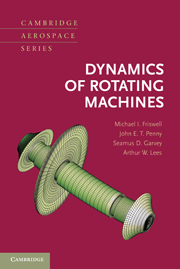Book contents
- Frontmatter
- Contents
- Preface
- Acronyms
- 1 Introduction
- 2 Introduction to Vibration Analysis
- 3 Free Lateral Response of Simple Rotor Models
- 4 Finite Element Modeling
- 5 Free Lateral Response of Complex Systems
- 6 Forced Lateral Response and Critical Speeds
- 7 Asymmetric Rotors and Other Sources of Instability
- 8 Balancing
- 9 Axial and Torsional Vibration
- 10 More Complex Rotordynamic Models
- Solutions to Problems
- Appendix 1 Properties of Solids
- Appendix 2 Stiffness and Mass Coefficients for Certain Beam Systems
- Appendix 3 Torsional Constants for Shaft Sections
- Bibliography
- Index
9 - Axial and Torsional Vibration
Published online by Cambridge University Press: 05 February 2015
- Frontmatter
- Contents
- Preface
- Acronyms
- 1 Introduction
- 2 Introduction to Vibration Analysis
- 3 Free Lateral Response of Simple Rotor Models
- 4 Finite Element Modeling
- 5 Free Lateral Response of Complex Systems
- 6 Forced Lateral Response and Critical Speeds
- 7 Asymmetric Rotors and Other Sources of Instability
- 8 Balancing
- 9 Axial and Torsional Vibration
- 10 More Complex Rotordynamic Models
- Solutions to Problems
- Appendix 1 Properties of Solids
- Appendix 2 Stiffness and Mass Coefficients for Certain Beam Systems
- Appendix 3 Torsional Constants for Shaft Sections
- Bibliography
- Index
Summary
Introduction
In Chapter 1, it is noted that the dynamic behavior of many rotors can be divided into three different classes: lateral, axial, and torsional. This chapter addresses both the axial and torsional behaviors of rotors. Generally, these two categories of behavior do not interact with one another, except in worm drives and bevel gears. Treating axial and torsional behavior together is justifiable because, mathematically, they are close analogies of one another. For cyclically symmetrical rotors, the analysis of both axial and torsional behavior is relatively simple. Thus, it is possible to provide an overview treatment of both in the space of a single chapter.
The degree to which a single rotor can be analyzed in isolation is different for the three classes of vibration. Lateral vibrations of a rotor are usually strongly coupled to the vibrations of the supporting stator and structure. The only significant exception to this is where very flexible bearings are in use. Passive magnetic bearings often provide this condition. By contrast, there is usually little coupling between torsional or axial vibrations of a rotor and any motion of the stator, except in the case of a geared system. Although this fact is helpful in analyzing the rotor, it often has the undesirable effect that even very severe torsional or axial vibrations in a rotor easily may go undetected by vibration probes on the stator. The analysis of torsional behavior is often carried out for a complete shaft train, whereas it is sometimes possible to analyze separately the axial and lateral behavior of the individual rotors in a shaft train.
Information
- Type
- Chapter
- Information
- Dynamics of Rotating Machines , pp. 383 - 419Publisher: Cambridge University PressPrint publication year: 2010
